The Dell XPS 15 9550 Review: Infinity Edge Lineup Expands
by Brett Howse on March 4, 2016 8:00 AM ESTGPU Performance
Other than the base model Core i3 powered XPS 15, all of the other models feature a 2 GB NVIDIA GTX 960M graphics card. The outgoing XPS 15 that we last reviewed featured a GT 750M, so the move to a Maxwell card should offer a better overall experience and with a more efficient design, which may come into play with the smaller chassis on the new XPS 15 9550.
The laptop was run through our standard gaming workloads. Of note is the Lenovo Y700 which has the same CPU but a 4 GB version of the GTX 960M, compared to the 2 GB one offered by Dell. We’ll see if that comes into play in the games we have here. The higher memory capacity should help as the resolution increases, but the GTX 960M is not going to be sufficient to game at UHD resolutions unless the game is not very demanding.
As always, you can compare the XPS 15 to any other laptop we’ve tested using our Notebook Bench.
3DMark

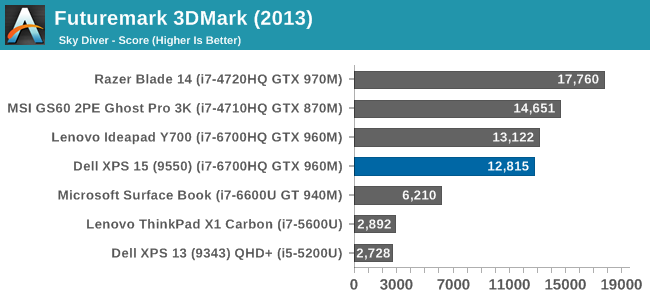
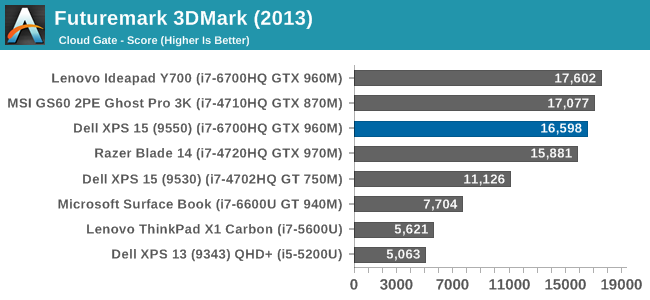
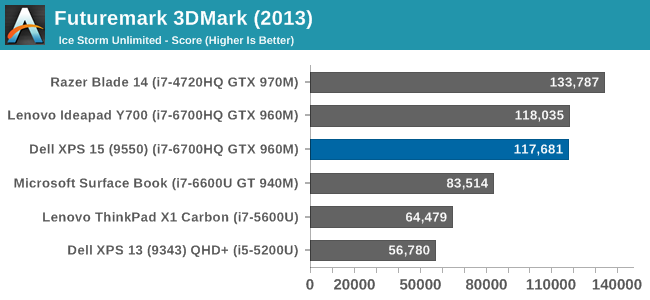
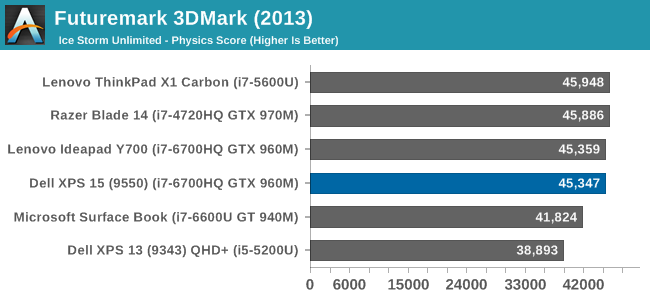
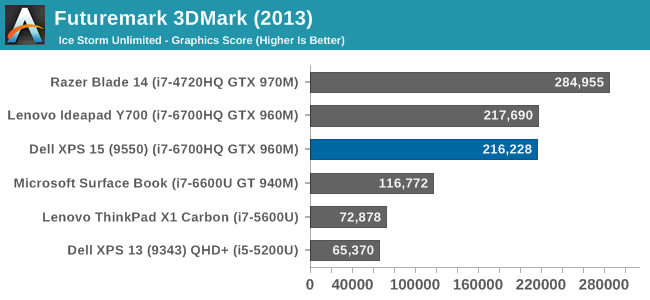
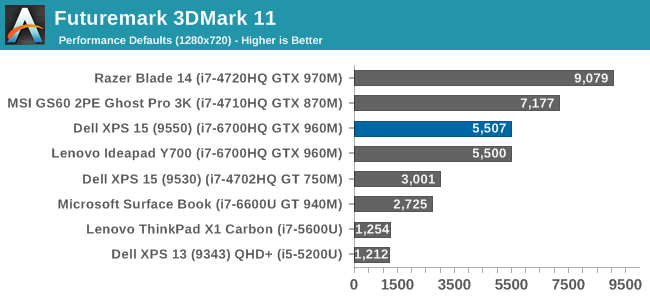
Our first synthetic test is FutureMark’s 3DMark. The latest 3DMark has several subtests, which start with the most demanding, Fire Strike, and decrease in demand going to Sky Diver, Cloud Gate, and Ice Storm Unlimited. The GTX 960M in the XPS 15 is fairly close to the Y700, which isn’t a shock, and the performance is a good step up from the GT 750M in the older XPS 15.
GFXBench
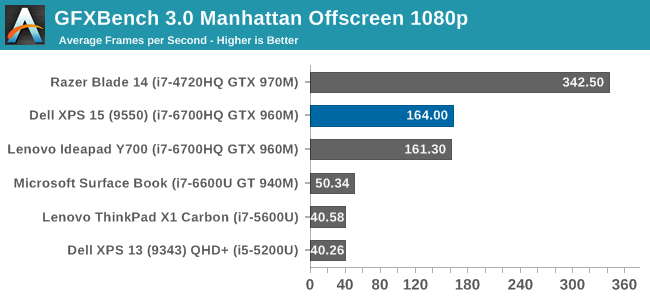
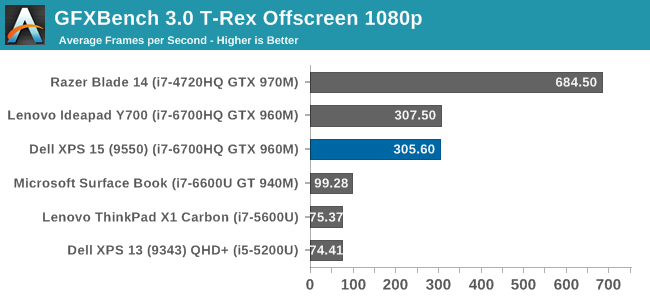
On our second synthetic test, we see the XPS 15 slotting right in around the same performance level as the Y700. Pretty much any PC with a discrete GPU can handle this benchmark at well over 60 FPS.
Dota 2
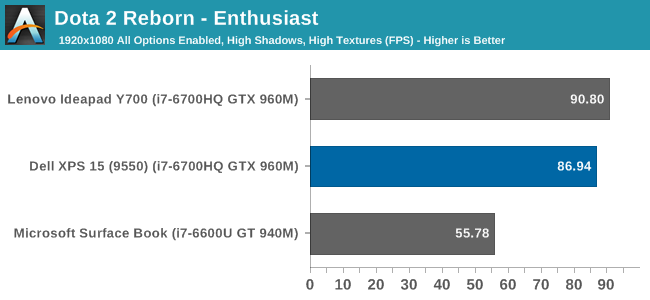
This Multiplayer Online Battle Arena game was recently revamped with a new game engine, which offers better visuals, but one that can still be played on low end hardware. The XPS 15 can handle this game very well at our enthusiast settings.
Tomb Raider
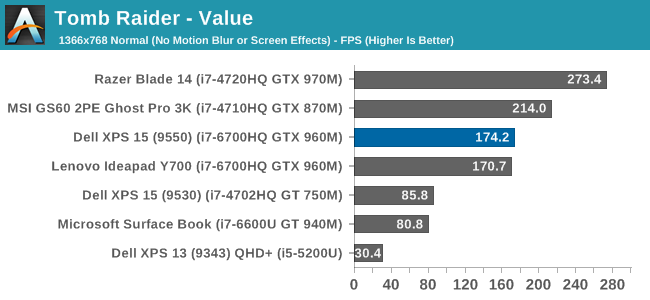
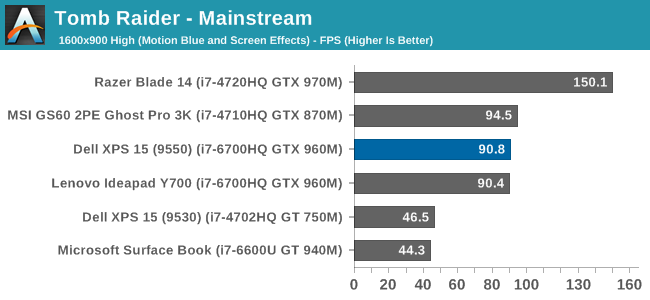

The latest version of this franchise has recently been released, but the original version can still be punishing on laptop graphics, especially with TressFX enabled. The XPS 15 can handle this game fairly well until you enable TressFX at 1920x1080, and then it struggles. It’s still a big jump over the older GT 750M equipped XPS 15.
Bioshock Infinite
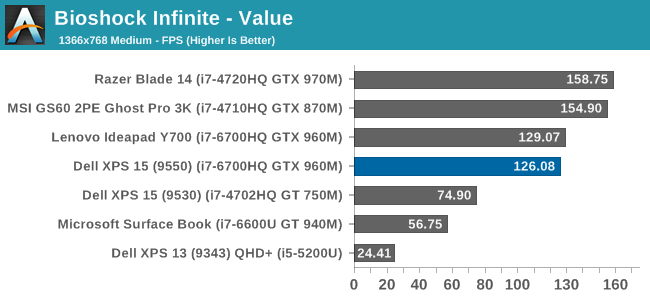

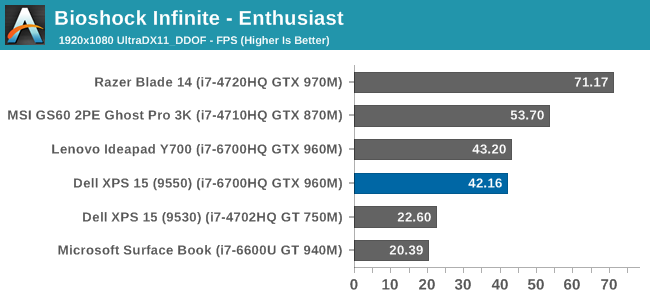
The XPS 15 can handle this game fairly well, but at the highest settings we test it will struggle. The performance is once again a big jump over the outgoing GT 750M, and the GTX 960M gives us over double the performance of the Surface Book’s GT 940M as well.
Dragon Age Inquisition



Bioware crafted a great game with Dragon Age Inquisition, and with maximum settings it can be punishing to lower end GPUs. The draw distances are quite impressive. The XPS 15 struggles at 1920x1080 Ultra, and some tweaking using the GeForce Experience would be needed to get an acceptable frame rate on this game. You can see that the XPS 15 pretty much mirrors the Y700 here, despite the Lenovo GPU having double the RAM on the GPU.
Shadow of Mordor



The well received action-adventure game from Warner Brothers and Monolith Productions uses the LithTech game engine, and with everything set to maximum at 1080p, the GTX 960M barely keeps an average over 30 frames per second, so once again this test is a bit too demanding for this laptop, but again the limited VRAM on the GPU does not seem to be affecting it at the resolutions and frame rates that the lower powered GTX 960M can achieve.
GRID Autosport



The EGO 3.0 engine can be tweaked quite a bit to allow this game to play on a large range of hardware. Even on maximum settings, the XPS 15 does very well.
GPU Conclusion
It’s great that we just reviewed another GTX 960M powered laptop, but it had the 4 GB version of the graphics card rather than the 2 GB version that Dell is shipping in the XPS 15. Despite half the memory, the graphics performance is pretty much even. It doesn’t seem to be a huge disadvantage with the games that we tested in any case. With higher resolutions, such as gaming at UHD resolutions, it would likely make a bigger difference, but the GTX 960M is already showing its performance limits at 1920x1080 gaming, so asking it to draw four times the pixels is likely a bit much.










152 Comments
View All Comments
BillyONeal - Friday, March 4, 2016 - link
Erm, at least the one I have isn't matte.Daniel Egger - Friday, March 4, 2016 - link
Multi-touch? I believe all multi-touch screens are glare out of necessity, with Dell XPS the non-touch types should be non-glare.DanNeely - Friday, March 4, 2016 - link
There's no reason they need to be, the OEM could directly apply the same anti-glare coating you can get in a screen protector to the glass at the factory. They don't because a majority of people seem to prefer the smoother feel of glass to the slightly rougher surface of an matte surface. Hopefully as highdpi screens become more common market volumes will be large enough to support both types of screens at reasonable costs. Alternately, install a matte protector in the factory where cleanroom facilities can be made available to avoid dust headaches that make installing larger protectors a PITA.I'm indifferent to the feel and prefer the matte appearance. However I have a protector on my phone but not my tablet or laptop; although that's primarily driven by the difficulty of getting a dustfree install on larger screens. I know other people swear by it, but I'm 0/2 with large protectors in a shower fogged bathroom.
nerd1 - Friday, March 4, 2016 - link
Why are you looking after inferior OS with fewer applications?Daniel Egger - Saturday, March 5, 2016 - link
OS X is the most productive platform (of the many I use daily), plain and simple. Linux is nice and quick for command line interaction and running server applications but seriously lacks in the day to day job desktop area. Windows is great for gaming but sucks balls in pretty much any other department. "Inferior" is very much in the eye of the beholder; from a technical standpoint it certainly is not but clearly not everyone is capable being the judge of that.The *only* Windows application I *need* to use for work every now and then for which there is no good native Linux or Mac equivalent is XenCenter but for that I do have a sufficiently working Wine Bottle; for everything else I do have very capable applications, some of which are not even available for Windows...
nerd1 - Saturday, March 5, 2016 - link
I run all three OSes (windows, OSX and linux) on different machines and OSX has the worst file and windows management among three, even with EC (which seems to cause more harm than good)Daniel Egger - Sunday, March 6, 2016 - link
Nonsense, it has the best windows management (without tinkering) and either best or second best file organisation (with Linux) depending on what features you need and filesystem you're using on Linux; the legacy file organisation from Win 3.1 times is totally bogus and maybe you don't happen to have noticed but in non-English languages they're basically the only OS using translated names in the file system for some system directories making Windows essentially the only OS where you can't switch languages after the fact and causing lots of funnies when writing software. The only thing that truly sucks on OS X is fork performance (compared to Linux): A complex script run on OS X is usually executed a magnitude and some slower than on Linux, so if you compile a lot of cross-platform software (like me) you're loosing lots of wall time there...The things that bother me most about Windows are:
- It provides horrible privacy even after manually adjusting all of the 80 (partially hidden!) settings
- It is still quite unsecure, you'll have to install and maintain lots of tools to make sure you don't pick up any malware
- It comes with pretty much no usable tools, so just to get the bare minimum onto a fresh installation you'll have to spend a full weekend with chocolatey and/or portableapps just to make it usable
- Commandline is pretty much unusable, doing most of the work with a UI is a magnitude slower than on Unixish OSes
- Keeping all applications up-to-date is *the* *horror* and chocolatey unfortunately doesn't help much lately
- Weekly security updates, in Windows 10 even enforced, enforce a reboot completely disrupting the workflow. On OS X is usually have an uptime of many *months* before an update forces me to do a reboot and even then the state of my environment is preserved so I can basically ACK the reboot, pick up a coffee and continue where I left off. In Linux only Kernel updates require a reboot and those necessary for security usually only occur every other year or so.
Enough ranting for me on this topic. Just the view from a single IT and software development pro, YMMV.
ESC2000 - Sunday, March 6, 2016 - link
I can't speak to a lot of that but I can't believe you're claiming that OSX has a better file system or window management system. Even diehard OSX fans generally seem to admit that those are weaknesses of OSX. Can you even "snap" windows into place on OSX like you can on windows? My mom switched to OSX 3 years ago and still complains that she sometimes can't find files which is one of the reasons her next computer will be a PC. Malware or the lack thereof is admittedly a plus in the OSX column.sphigel - Friday, March 4, 2016 - link
These storage options are infuriating. You have to get the i7 model just to get an SSD?! That's ridiculous. SSDs benefit everyone regardless of how much processing power they need. They should be offered on every configuration.osxandwindows - Friday, March 4, 2016 - link
So true